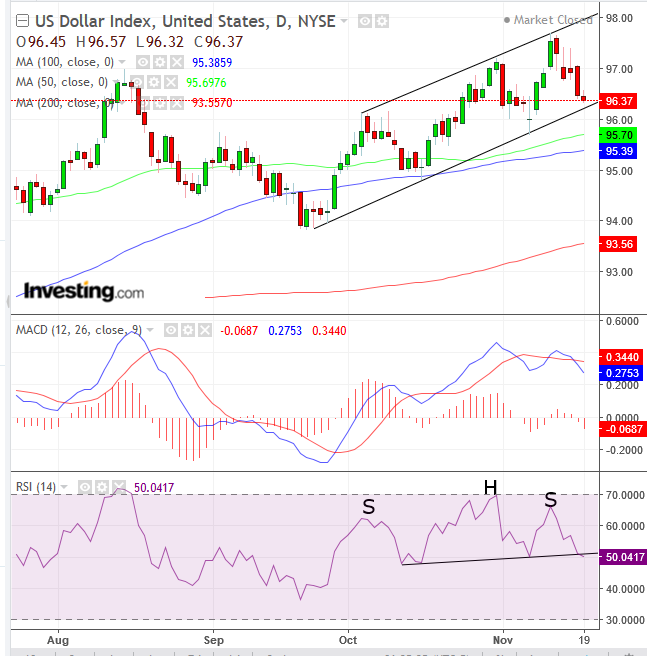The dollar is down more than 0.1 percent as of this writing, the third day of declines over the past four days, for a combined loss of 1.22 percent. It's the global reserve currency's most significant weekly setback in two months, following dovish rhetoric by the Fed.
The selling started after Federal officials warned of slowing global growth. Dallas Fed President Robert Kaplan told Fox Business he sees an economic slowdown in Europe and China. Richard Clarida, the Fed’s newly appointed vice chair, cautioned similarly, saying “that’s something that is going to be relevant” for the outlook for the US economy. Note that neither talked down the US economy per se. Rather, they intimated that US economic activity, as robust as it is, cannot thrive in a bubble.
That's the current market narrative. The dollar, however, has already been trading within a short-term downtrend, since Tuesday, three days before either Fed official spoke.
Fundamentally, the dollar followed Treasury yields lower. Technically, it had reached the resistance of the top of its rising channel.

Last week we pointed out that the dollar confirmed its mid-term uptrend and forecast a correction to the channel bottom. Indeed, this started the very next day and has been in play ever since. Now, based on the weight of the evidence, we predict a return toward the channel top.
In our previous post, we advised conservative traders to wait for a full mid-term correction, which has now occurred. At this point, to carry out the trade described in our earlier post, they must wait for the confirmation of the mid-term’s uptrend.
In the same post we suggested that aggressive traders should ride the potential correction, whose target was achieved today.
The price fell as much as 0.09 percent earlier today, but pared even that incidental loss to 0.02, as of the time of writing. After Friday's 0.47 percent dollar selloff—the steepest in over two weeks—why has all the air run out of the downward movement?
Fundamentally, because the US economy is still booming and the Fed speakers warned of an indirect slowdown. As well, Clarida defended the central bank's pace of interest rate hikes and Chicago Federal Reserve President Charles Evans said he sees up to 4 interest rises in 2019, above the so-called "neutral rate." Technically, the price-action has reached the support of the bottom of a rising channel, where demand has been outpacing supply, as well as the 50 and 100 MAs.
However, the picture isn't completely rosy. The USD must still contend with the resistance of the mid-August weekly shooting-star, whose top is 96.98, as is indicated by the bearish daily MACD —whose signal has been fluctuating and is now once again in a sell position again, and the daily RSI, which is flirting with a downside breakout of an H&S top pattern.
In addition, while the price crossed above the 200-week MA in mid-October, its 100-week MA fell below the 200-week MA of early-September.
Trading Strategies
Conservative traders may choose to wait for a long position with confirmation that the rising mid-term trend will endure past the 96.98 resistance of the weekly shooting-star from mid-August. They would then wait for a correction which confirms the rising trend.
Moderate traders may risk a long position upon confirmation of demand kicking in, with at least one long, green candle.
Trade Sample
- Entry: 97
- Stop-loss: 96.50
- Risk: 50 pips
- Target: 98.5
- Reward: 150 pips
- Risk-Reward Ratio: 1:3
Aggressive traders may enter a long position, with a stop-loss beneath the rising channel
Trade Sample
- Entry: 96.35
- Stop-loss: 96
- Risk: 35 pips
- Target: 97.40, below the previous peak’s resistance
- Reward: 105 pips
- Risk-Reward Ratio: 1:3
